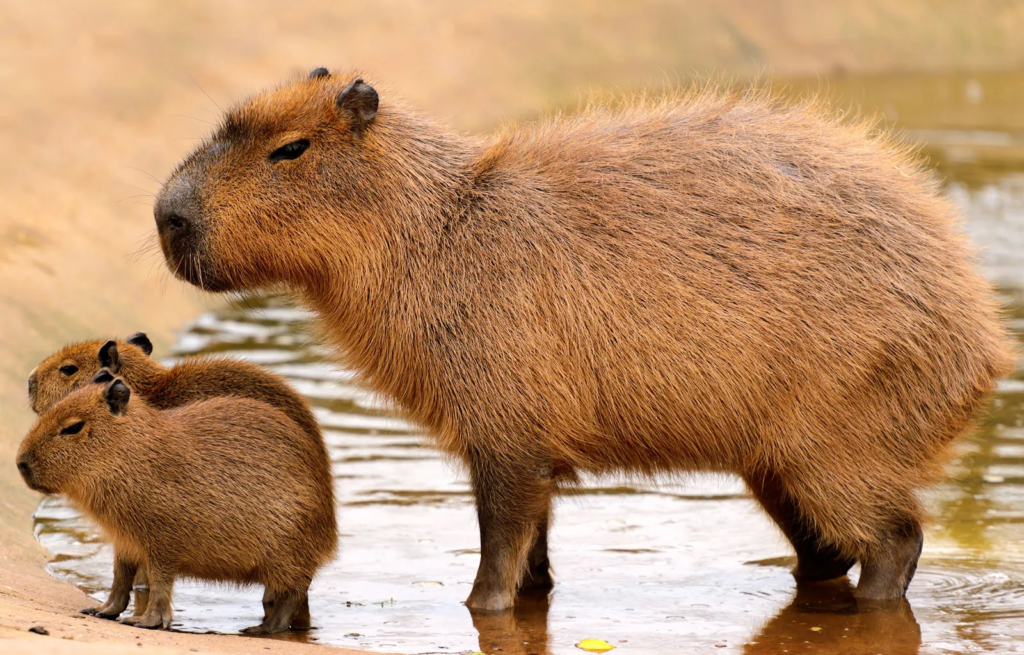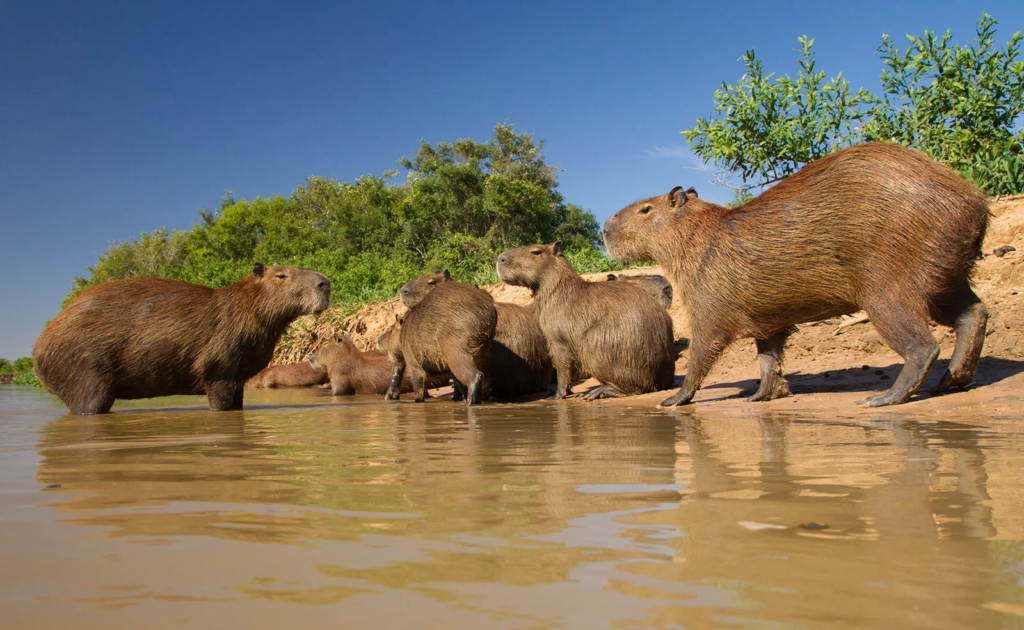About Capybara
Capybara: The Largest Rodent on Earth
The capybara (Hydrochoerus hydrochaeris) is a fascinating semi-aquatic rodent native to South America. Known for being the largest living rodent on the planet, this gentle herbivore is both unique in its physical traits and behavior. Here’s a detailed look at the capybara’s life, habitat, diet, and much more.
Classification
- Common Name: Capybara
- Scientific Name: Hydrochoerus hydrochaeris
- Type: Mammal
- Diet: Herbivore
- Group Name: Herd
- Family: Hydrochoeridae (sometimes classified under subfamily Hydrochoerinae of the family Caviidae)



Physical Characteristics
Capybaras are large, short-haired rodents that resemble guinea pigs, but on a much larger scale.
- Size: Up to 4.6 feet long and about 2 feet tall at the shoulders.
- Weight: Typically between 77 and 143 pounds, with some individuals reaching up to 174 pounds.
- Appearance: They have brownish fur, blunt snouts, short legs, small ears, and almost no tail.
- Aquatic Adaptations: Their toes are partially webbed, allowing them to swim efficiently. Their eyes, noses, and ears are positioned high on their heads so they can remain alert even while submerged.
The capybara’s pig-shaped body is perfectly adapted for life in wetlands, forests, and seasonally flooded savannas.
Habitat and Range
Capybaras inhabit a wide range of ecosystems throughout northern and central South America, from Panama to Argentina.
- Preferred Habitat:
- Wetlands
- Forests
- Seasonally flooded savannas
- Riverbanks and lake shores
The larger capybara species (Hydrochoerus hydrochaeris) is primarily found in remote areas from Venezuela to northern Argentina and the Amazon basin. The lesser capybara (H. isthmius), a smaller species, inhabits areas from central Panama to northwestern Colombia and far northwestern Venezuela.



Behavior and Social Structure
Capybaras are social creatures that live in groups of up to 40 individuals, though they can also be found alone.
- Activity Patterns: Their daily activity shifts between day and night depending on seasons and predator presence. Dawn and dusk are often peak times for activity.
- Group Dynamics: Capybaras live in herds for protection and social interaction, with groups often led by a dominant male.
- Shyness: Though social, they are shy animals that spend much of their time near water to avoid predators.
Adaptation to Predators
Capybaras are prey for a variety of predators, including jaguars, pumas, caimans, anacondas, and boa constrictors. Their young are particularly vulnerable to crab-eating foxes, small wildcats, and birds of prey like the black vulture and caracara. To evade predators, capybaras are adept swimmers and divers, often escaping into the water.
Diet and Feeding Habits
Capybaras are strict herbivores that graze on aquatic plants, grasses, and other vegetation. Their diet reflects both their unique adaptations and the challenges of their environment.
- Primary Diet:
- Aquatic plants
- Grasses
- Leaves
- Occasionally melons, grains, and squash in cultivated areas (which can make them pests).
- Unusual Eating Habits:
- Like other rodents, their teeth grow continuously, and grazing helps keep their teeth worn down.
- Capybaras eat their own feces in the morning. This process, known as coprophagy, allows them to digest their food twice to maximize nutrient absorption, especially since grasses are hard to digest.
Reproduction and Life Cycle
Capybaras typically breed once a year, with litters ranging from three to eight young.
- Gestation Period: Approximately 100 to 110 days.
- Young at Birth: Baby capybaras are precocial—they are born with their eyes open and furred, capable of walking shortly after birth.
- Breeding Season: Varies depending on the habitat and availability of mates.
The average lifespan of a capybara in the wild is up to 7 years, though they may live longer in captivity due to the absence of predators and consistent food availability.
Conservation Status
Capybaras are currently listed as Least Concern by the International Union for Conservation of Nature (IUCN), with stable populations overall. However, local populations face significant threats in some areas due to:
- Hunting:
- In some regions, capybaras are hunted for their meat and hides.
- The smaller species, H. isthmius, is more commonly hunted, while the larger species is often ranched for commercial purposes.
- Habitat Destruction:
- Agricultural expansion and development in wetlands and forests threaten their natural habitats.
Fun Facts About Capybaras
- Largest Rodent: Capybaras are the largest rodents on Earth, easily twice the size of a beaver.
- Social Swimmers: They love water and are strong swimmers, often staying submerged with only their noses and eyes above water.
- Closely Related to Guinea Pigs: Capybaras share their family tree with guinea pigs, rock cavies, chinchillas, and agouti.
- Diet Double-Take: Eating their feces may sound gross, but it’s a key strategy for digesting tough plant matter!
- Invasive Population in Florida: A small invasive population has been observed in Florida, where they have adapted to local ecosystems.
Capybaras are truly remarkable animals with unique adaptations that make them perfectly suited for life in South America’s wetlands and forests. From their social structure to their unusual dietary habits, every aspect of the capybara’s life demonstrates their resilience and importance to their ecosystem.
Whether swimming to evade predators or grazing by the water’s edge, capybaras are a testament to the incredible diversity of the animal kingdom. Protecting their habitats and understanding their role in the environment can help ensure these gentle giants continue to thrive for generations to come.
